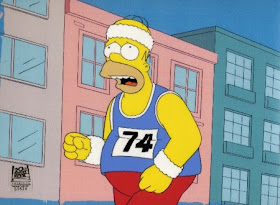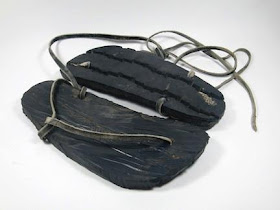 |
| Hopi Snake Priests, 1907 |
The Hopi are a Native American pueblo tribe who for the past thousand years or so have lived on and around three mesas in what is now northeastern Arizona. During that time, the tribe has produced many of the world's best runners.
 |
| Walpi, 1920 |
Hopi culture has always been intrinsically tied to running. In Hopi tradition, the people learned running from their ancestors and animals, and mythical footraces between spirits helped shape the world. In recent centuries, the Hopi have run for hunting, war, travel, sport, communication, health, religious purposes, and to foster bonds between villages. In lieu of rain dances, the Hopi often run races to bring rain. One traditional race, the Snake-Antelope race, involves carrying water from a sacred spring in a gourd, with the leading running runner taking the gourd from the runner he has passed. Although a runner is declared the winner, the race is ultimately for the benefit of all. As one runner of the 1906 race recalled, "We were doing it because we were the clouds. The people were the clouds, do you see? We were the clouds coming to give us rain." (
Paatuwaqatsi ("Water is Life"), the 50k I'm running this weekend, is in a way a continuation of this tradition.)
 |
| Antelope dance |
Hopi runners competed with neighboring villages in kick-ball races similar to those of the Tarahumara of Mexico, except that for the Hopi the races always held a strong connection to the spiritual world. The cloud gods were believed to rejoice to see Hopi youth run, and so, even though each runner competed for his clan, the running helped the community as a whole by allowing the prayers for rain to be heard. The young runners often went barefoot, even through cactus and thorny bushes.
In addition to aiding the community, "Hopis believe that running banishes unhappiness, strengthens the body, and
rejuvenates a person’s energy."
 |
| Oraibi c.1872-81 |
Running took on a more practical and sinister role in the 1680 pueblo revolt. After 80 years of Spanish rule, the pueblo peoples of current day eastern Arizona and western New Mexico (numerous tribes, including those of Hopi, Zuni, and Taos) were tired of the brutality of their rulers and decided to band together and force the Spanish from their land once and for all. In order to coordinate their attack, runners left from Taos (in western New Mexico) and traveled west to each of the pueblos, ending 300 miles later at Oraibi on the western edge of the Hopi land. The messengers carried knotted cords which told how many days were left until the time to attack. When the day came, the revolt was bloody but effective. The Spanish were completely swept from the land, and although they eventually returned, they never exerted the same level of control over the area.
 |
| This church, near Oraibi, was burned down in the 1680 revolt |
After the U.S. acquired the territory, many who interacted with the Hopi were dumb-founded by the speed of Hopi messengers. Soldiers would frequently hire Hopi runners to carry messages for them since the runners were faster than horses over long distances and rough terrain. One army officer tells of a runner leaving Oraibi at 4pm and delivering the message in Winslow (65 miles away) at midnight. (That's 65 miles at a 7:22 average pace, mostly in the dark.) After delivering the message, the runner turned around and ran back home. Another account (from a different army officer) relates how a Hopi runner named Letayu carried a message from Keams Canyon to Fort Wingate, NM and back in three days, a round trip of 200 miles. Letayu ran the entire 100 mile return trip on the third day, arriving in the afternoon. Around 1909, when some renegade Navajo were causing trouble, the local Indian agent at Tuba City summoned Charlie Talawepi at 3am and gave him a message to take to Flagstaff, over 75 miles away. Talawepi delivered the message around noon, fueling on
piki bread along the way, and started the return trip after a half hour break. He got back to Tuba City around 10 or 11pm, having covered over 150 miles in 19-20 hours, averaging around a 7:30 pace. Years later, Talawepi's grandson remembers him saying that it was the longest distance he had ever run and that he was sore for several days afterward, but that "he didn't think that it was a big deal."
 |
| San Francisco Peaks, near Flagstaff |
In the early twentieth century, the U.S. government's policy of forcibly removing Native American children from the reservation and placing them in government-run boarding schools had the collateral effect of introducing an influx of Hopi running talent into the international track and field scene. The most famous of this generation was Lewis Tewanima (
I previously wrote about Tewanima here).
A classmate of Jim Thorpe at Pennsylvania's Carlisle Indian School, Tewanima competed in the 1908 and 1912 Olympics. At the 1912 games he won silver in the 10,000 meters and set a U.S. record that stood for 52 years.
Another Hopi who made the Olympic team that year was Philip Zeyouma. He ran for the Sherman Institute, another Indian boarding school in Riverside, CA. He secured a place on the 1912 Olympic marathon team by winning the L.A. Times Modified Marathon, a 12 mile race that functioned as the west coast Olympic trials. He attracted notice by running in traditional Hopi moccasins and wearing a shirt which depicted the flying snake of Hopi folklore.
 |
| Philip Zeyouma (notice the winged snake on his shirt) |
Zeyouma's victory meant that the U.S. had selected not one but two Hopi runners to compete in the marathon at the Stockholm Olympics. Unfortunately for those hoping to see a showdown between the two, Zeyouma ultimately decided not to compete, honoring the wishes of his father who disapproved of his participation in the games.
Nonetheless, the showdown between the two runners did occur that September when Tewanima (fresh from medaling in Sweden) and Zeyouma decided to challenge each other to a 12 mile race on the Hopi reservation. When the two showed up for the race in their school track uniforms, some of the older men made fun of them for not looking like Hopis. Tewanima responded by challenging them to race as well. The men promptly agreed and the race began, with the older men running barefoot. Only six miles in, neither of the Olympians could keep up and both dropped out of the race. According to an observer, the winner was around fifty years old and looked like he was
"dying of consumption." Apparently, the track and field world had only gotten a taste of Hopi running talent.
[To read more about Hopi running, check out Matthew Sakiestewa Gilbert's articles]
---------------------------------------------------------------------------------------------------------
Read my other posts about
Runners You Should Know
---------------------------------------------------------------------------------------------------------















































